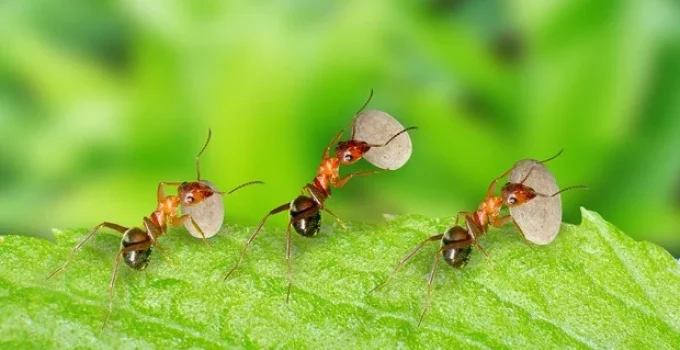What Do Ants Eat?
Ants are omnivores, meaning they eat a wide variety of foods—ranging from sugars and proteins to fats and even other insects. Their diets vary depending on species, environment, and their role within the colony. From sweet sap to scavenged meat, ants are resourceful foragers capable of digesting complex and diverse substances.
🧭 Dive Deeper
- What Types of Food Do Ants Prefer?
- Do All Ants Eat the Same Thing?
- How Do Ants Find and Process Food?
- What Do Ant Larvae Eat?
- Table: Diet Preferences by Ant Species
- 🎯 Final Thoughts
- 📚 References
What Types of Food Do Ants Prefer?
Ants consume three primary macronutrients:
- Carbohydrates for energy (from nectar, honeydew, fruits)
- Proteins for growth and development (from dead insects, meat, seeds)
- Fats for energy storage and metabolic needs (from seeds, oils, and prey)
🧁 | Stat: In a 2022 study, over 60% of urban ant species were observed preferring sugary substances over proteins, especially in warmer months [1].
Their preferences often shift based on seasonal needs, colony size, and the presence of developing larvae (which require more protein).
Do All Ants Eat the Same Thing?
No, ant diets vary significantly between species, castes, and life stages.
Species-based differences:
- Carpenter ants (Camponotus spp.) feed primarily on sweet substances, including honeydew from aphids.
- Army ants (Eciton spp.) are predators, eating other insects, spiders, and even small vertebrates.
- Leafcutter ants (Atta spp.) don’t eat leaves directly. Instead, they use them to farm a specific fungus, which is their primary food source [2].
Caste-based differences:
- Worker ants forage and may consume small amounts of what they find.
- Queen ants are fed by workers with pre-digested, nutrient-rich food.
- Males have short lifespans and consume little to no food after maturity.
How Do Ants Find and Process Food?
Ants use chemical signals called pheromones to locate and communicate about food sources. When a scout ant finds food, it lays a pheromone trail back to the nest, allowing others to follow.
Key behaviors include:
- Trail foraging: Ants follow scent lines to known food sources.
- Recruitment: More ants are dispatched once a valuable food source is located.
- Food sharing (trophallaxis): Ants share liquid food mouth-to-mouth, redistributing nutrients throughout the colony.
🍯 | Fun Fact: Some ants “milk” aphids by stimulating them to release honeydew, a sugary secretion, which the ants then consume.
What Do Ant Larvae Eat?
Ant larvae have different dietary needs than adults. While adults primarily consume liquids, larvae can digest solid foods, including:
- Chewed prey
- Fungal material (in fungus-farming ants)
- Protein-rich secretions from worker ants
In some species, larvae digest solid food and regurgitate it in a liquefied form for the queen and other workers. This system allows the colony to consume a wider variety of foods despite the adult ants’ limited digestive capabilities.
Table: Diet Preferences by Ant Species
| Ant Species | Primary Diet | Unique Food Behavior |
|---|---|---|
| Camponotus spp. | Sugars, honeydew | Tend aphids for nectar-like honeydew |
| Eciton spp. | Insects, spiders | Group hunting and mass raids |
| Atta spp. | Fungus (grown on leaves) | Use leaf fragments to farm fungus |
| Solenopsis invicta | Sugars, proteins, fats | Aggressive scavenging and predation |
| Lasius spp. | Honeydew, insects | Build shelters over aphid colonies |
🎯 Final Thoughts
So, what do ants eat? Ants are dietary generalists with highly adaptable feeding strategies. From tending aphids for sugary honeydew to harvesting leaves for fungus farming, ants have evolved diverse ways to obtain the nutrients they need. Their collective foraging and internal food-sharing systems allow colonies to survive in a wide range of environments—making ants some of the most successful eaters on Earth.
📚 References
- Penick, C. A., Savage, A. M., & Dunn, R. R. (2022). Dietary shifts in urban ants: sugar preferences dominate in developed landscapes. Journal of Urban Ecology, 8(1), juac012. https://doi.org/10.1093/jue/juac012
- Hölldobler, B., & Wilson, E. O. (1990). The Ants. Harvard University Press.
- Weber, N. A. (1972). Gardening Ants: The Attines. The American Philosophical Society.
- Roces, F., & Núñez, J. A. (1996). Trophallaxis and foraging behavior in ants: communicating the colony’s food needs. Behavioral Ecology and Sociobiology, 39(4), 261–267.
- Tschinkel, W. R. (2006). The Fire Ants. Harvard University Press.
- Harvard Forest – Harvard University – Ant Food Web. https://harvardforest.fas.harvard.edu/education-opportunities/classic-outreach-resources/ants-north-quabbin-region/ant-food-web/
📌Learn More About Ants
- How Do Ants Reproduce?🐜A Deep Dive Into Colony Growth
- Do Ants Have Blood?🐜 The Surprising Truth about Insect Circulation
- Can Ants Smell? 🐜 Exploring the Chemical World of Ant Communication
- Can Ants Swim? 🐜 Exploring the Aquatic Abilities of Earth’s Hardest Workers
- Do Ants Eat Termites? 🐜 The Many Termite Predators
- Do Ants Have Brains? 🐜 Inside the Mind of Nature’s Minature Engineers
- Do Ants Have Muscles? 🐜 Explore What These Muscular Powerhouses Can Do
- Do Ants Sleep? 🐜 Ants Are Supersonic Power Nappers!
- How Long Do Ants Live? 🐜 A Look Into the Lifespan of the Colony
- What Do Ants Eat? 🐜 Inside the Pantry of an Ant Colony
- Are Ants Blind? 🐜How These Tiny Insects See the World
